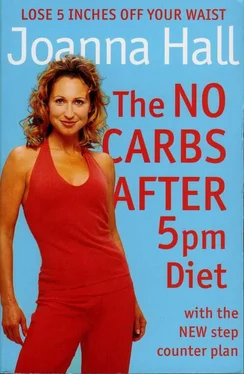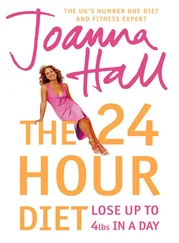However, like anything else, drinking more water than you need does not increase its health benefits. Indeed, drinking excess water can cause a dangerous condition called hyponatraemia.
To spread your water intake through the day, try to drink two glasses of water before or with each meal. Simply tick the box each time you have a glass. The water tally column will naturally guide you to consume eight glasses a day, but if you drink more simply add these to your drinks section of the chart.
The portion distortion symbols are your easy calorie-control guide. Simply tick the symbol that represents the size of the food item you have eaten. If you eat more than one portion size of a food, you’ll find space next to each symbol to record how many more servings you eat.
“Portion distortion has changed my life – I’ve never felt better. It’s so clever, simple and easy to do that no one need ever know you are following a diet!”
When to Fill in Your Daily Chart
The most important aspect of filling in your charts is to be accurate. I know filling them in may seem a chore, but it really will make you focus on the plan.
In my experience with clients, the more time you leave between eating and recording, the more errors occur. So do try to keep this book with you so you can record at each meal. If you find this book a bit bulky to carry around, visit my website and print off these charts for free. Then you can keep them in your handbag, on your desk or on your PC!
Another approach I have found very effective with clients is to write down what you plan to eat for the whole day at the start of the day. This can be particularly helpful if you are the sort of person who tends to get very hungry before meals and grabs things on the run to stop the hunger pangs and energy slump. Filling in the chart this way will mean you need to be more organized but more focused. If you record what you plan to eat in one colour and then add any other food you have eaten in another colour, you can easily keep a hold on reality.
PREVIEW AND REVIEW CHARTS
On days 1, 7, 14, 21 and 28 you need to complete your preview and review charts.
These help you plan your week ahead. They guide you to plan when you will be able to take your structured walks and do your abdominal exercises. They also address the difficulties you anticipate over the next seven days that may hinder your efforts.
Previewing is so important. I’m in no doubt you will come across a few challenges over the 28 days – maybe you are going to a huge blow-out party, it’s your child’s birthday tea party, you have deadlines at work, or an ill family member needs care. This is life, and how you deal with these events is part of your road to success.
The first thing to do is acknowledge them by writing them down in the Challenges section of your Preview chart, and perhaps to adjust your walking goals and times when you can commit to doing your abdominals. Remember, the 28-day plan is about building on a Template of Success. Over-committing yourself will only make you feel like you have failed.
Next, tick which of the following categories you think the following week will fall into: ‘progressive’, ‘maintenance’ or ‘damage limitation’.
A progressiveweek is one where you feel 95 per cent confident you can complete all the aspects of the plan you have committed to on your Preview chart. You feel good about yourself; you feel motivated that you have planned ahead and happy that you can deal with any little blips that may come your way that week.
A maintenanceweek is one where you feel 75 per cent confident that you can complete your programme goals for the next seven days. You feel you may not be able to achieve all the daily walking goals, and you may have a few things to deal with that could make it difficult to follow the plan exactly, but you feel you can give it your best shot. You are confident that these little blips are not going to make your efforts lapse.
A damage limitationweek is one where you feel your life is not conducive to following the plan – perhaps the children are breaking up from school, the washing machine has flooded the floor, it’s your time of the month, you have major hassles at work and you have guests all weekend. Damage limitation weeks happen – you do need to acknowledge that – but rather than thinking ‘I’ll drop the plan this week, have a complete rest and pick it up again next week’, DON’T! Limit the damage and pick one thing on the plan you can do all week. Perhaps it’s your Carb Curfew or your daily accumulated walking targets, completing half the daily walking goals instead of all of them. Think carefully and plan – you can limit the damage, and this is all part of building that Template of Success The first step to limiting the damage is acknowledging it is a damage limitation week on your Preview chart.
“I am not the most motivated of people so I found the weekly review and preview helped keep me on track.”
Navigating all the challenges life throws your way is actually a success. OK, you may not always be able to complete the daily walking goals but the aim is for you to do something each day and feel good about it. This is success and this is building on your Template of Success. Many of my clients have blips on the programme when they aren’t able to do all the daily walking goals they wanted or perhaps slipped off the eating principles, but the trick is not to let a little lapse become a collapse. Even if you have a lapse, you will still see a huge difference in your body if you stick with the plan (see Chapter 11).
These allow you to look back over the past seven days and see how you did. They encourage you to give yourself a pat on the back with your progress but, equally, to assess whether what you are expecting from yourself is realistic. Perhaps you ticked that you would do your abdominal exercises every day in the previous Preview chart on day 7. When you come to review it on day 14, however, you find you didn’t actually do your abdominals once. This means you need to reassess how you fill in the Preview chart for the following week. The Review and Preview charts act as a reality check, keeping you on track and building a Template of Success. You’ll find lots of ideas on how to deal with challenges and to stop a lapse becoming a collapse in Chapter 12.
THE ENERGY GAP
If you want to lose weight you have to create an ‘energy gap’ – put simply, you need to create as big a gap as possible between the number of calories you consume through food and drink and the number of calories you expend through moving your body. The amount of calories you consume through food and drink needs to decrease while the amount of calories you expend through moving your body has to increase. The bigger the energy gap you create on a consistent basis, the greater your success. The No Carbs After 5pm Diet will help you create an energy gap, with simple-to-implement exercise and eating principles. This will help you to lose weight and inches, and at the end of 28 days your body will burn more calories even when you are sleeping!
The No Carbs After 5pm Diet is based on a number of eating principles. Knowing the logic and science behind the diet will help you understand how and why it works. To make things simple, all the meal suggestions and recipes in the book put these principles into practice for you.
This is your Golden Rule.
Читать дальше












